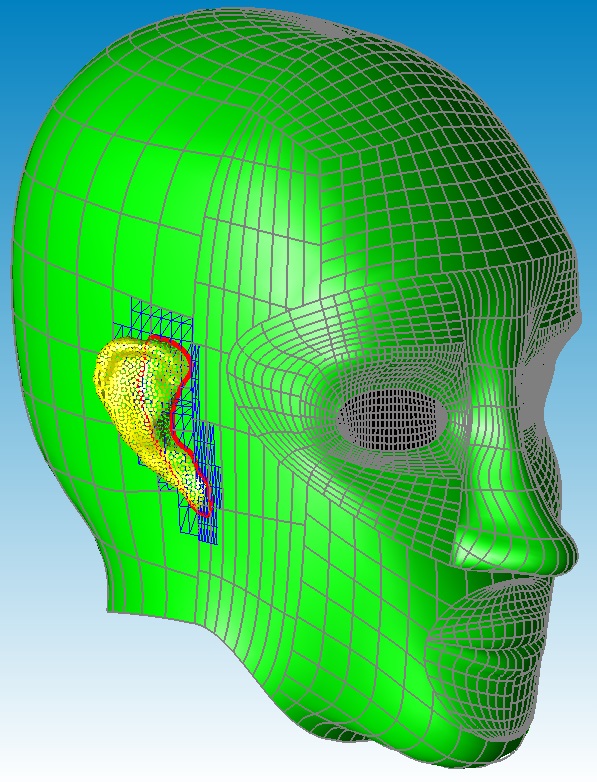ME 535 Computer-Aided Geometric Design
Instructor: Prof. Xiaoping Qian
The ability to understand, construct and process three-dimensional geometric models on the computer is essential for many modern engineering fields, such as computer-aided design and manufacturing (CAD/CAM), engineering simulation, biomedical imaging, robotics, computer vision, and computer graphics. This course focuses on CAGD techniques for modeling freeform curves and surfaces such as body shapes of ships, automobiles and aircrafts. Many consumer products as well as electronic devices are also designed with freeform aesthetic shapes.
|
|
|
|
|
Intersection of NURBS surfaces with a point-set surface |
Rational Bezier tetrahedral |
Maximum principal curvatures |
Course Description
This course covers mathematics and algorithms for defining, manipulating and querying three-dimensional geometric models, with emphasis on techniques for curve and surface modeling. These techniques are central to fields such as computer-aided design and manufacturing, computer graphics and animation, and are of growing importance to finite element (e.g. isogeometric) analysis. Applications of these techniques in 3D scanning and 3D printing are discussed in class.
Prerequisites
Math223 or equiv, or cons inst
Course Topics
2. Parametric curves
a. Hermite curve
i. blending functions
ii. matrix form
iii. basis conversion
b. Bezier curve
i. Bernstein polynomial and its properties
ii. Bezier curve properties
iii. differentiation
iv. matrix form
v. basis conversion
vi. de Casteljau algorithm
c. B-spline curve
i. recursive form of blending function
ii. Cox de Boor algorithm
iii. Differentiation
iv. Uniform B-spline, matrix form, and basis conversion
v. B-spline curve properties
d. Non-uniform rational B-spline (NURBS) curve
e. Blossoms: affine interpolation, knot insertion, degree elevation, Bezier extraction, derivatives, parametric continuity
3. Parametric surfaces
a. Bilinear patch
b. Hermite patch
c. Coons patch
d. Bi-cubic patch
e. Bezier surface
i. properties
ii. de Casteljau
iii. tensor product
f. B-spline surface
i. properties
ii. Cox de Boor
iii. tensor product
g. NURBS surface
i. Representation of extruded surface
ii. Representation of revolved surface
h. Triangular Bezier patch: surface evaluation, derivative, continuity
i. Blossom: tensor-product blossom, bivariate blossom
4. Geometric properties
a. differential geometry (local properties)
i. tangent and normal
ii. 1st and 2nd fundamental form
iii. normal curvature
iv. principal curvatures and directions
v. differential geometry of intersection curves
b. global properties
i. mass properties
5. Subdivision surfaces
a. Uniform subdivision of quadratic and cubic curves
b. Doo-Sabin subdivision surface
c. Catmull-Clark subdivision surface
i. Recursive refinement
ii. Direct parametric evaluation
iii. Basis function
d. Loop subdivision surface
6. Interpolation and approximation
a. Data parameterization
b. Interpolation
c. Approximation
7. Applications (tentative)
a. Surface reconstruction in 3D scanning
b. B-spline based shape optimization
c. Path generation in NC machining
i. Tool path resolution and accuracy
ii. Planning step length and path interval
iii. CC based method for generating linear segments: Isoparametric and Cartesian plane method
iv. CL based method for generating freeform curve segments: surface/surface intersection, orthogonal projection, curve tracing through Runge-Kutta, maximum scallop point, B-spline curve interpolation.
d. Slicing in 3D printing
e. Design application (geometric design, mesh generation, and optimization)
Textbook: None.
References
1. Gerald Farin, Curves and Surfaces for Computer Aided Geometric Design, A Practical Guide. Morgan Kaufmann, 5th ed., ISBN 1-55860-737-4, 2002.
2. H. Prautzsch, W. Boehm, M. Paluszny, Bezier and B-spline Techniques, Springer-Verlag, 2002.
3. Nicholas M. Patrikalakis and Takashi Maekawa, Shape Interrogation for Computer-Aided Design and Manufacturing, Springer 2001.
4. CAGD Notes at UC Davis
5. M. Mortenson, Geometric Modeling, 2nd edition, John Wiley, ISBN 0471129577, 1997
6. Choi, B. K. and Jerard, R. B., Sculptured Surface Machining, Kluwer Academic Publishers, 1998.
7. Design Mentor and Computing with Geometry from Michigan Technical University
8. Isogeometric Analysis for Subdivision Surfaces, Pieter J. Barendrecht, Eindhoven University of Technology: Eindhoven, The Netherlands.


